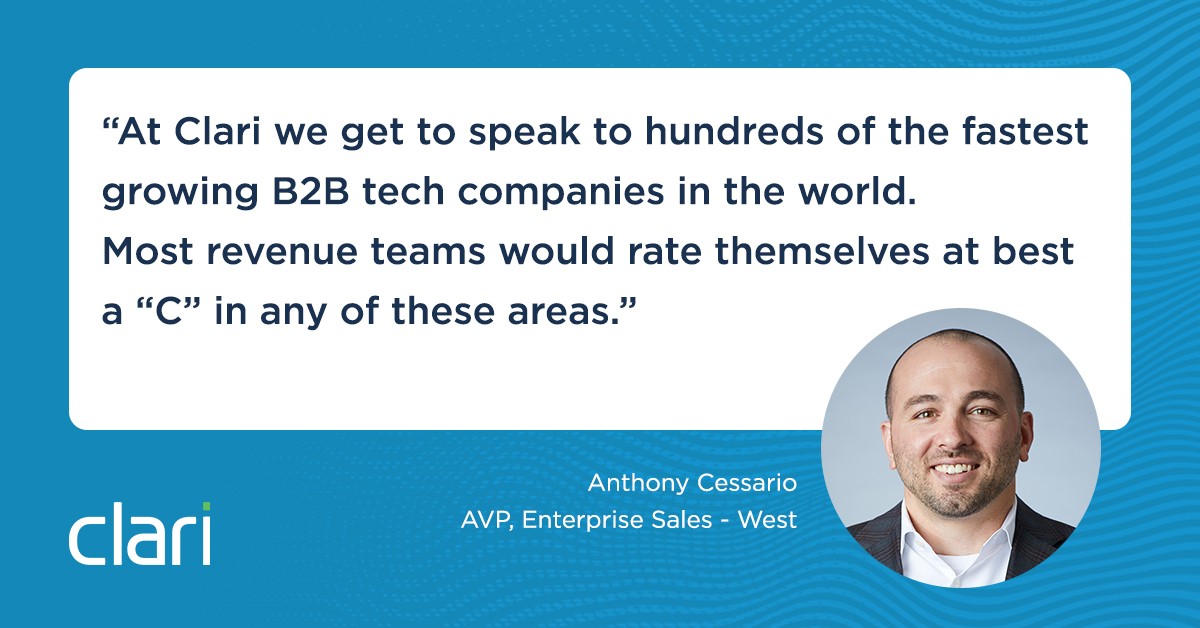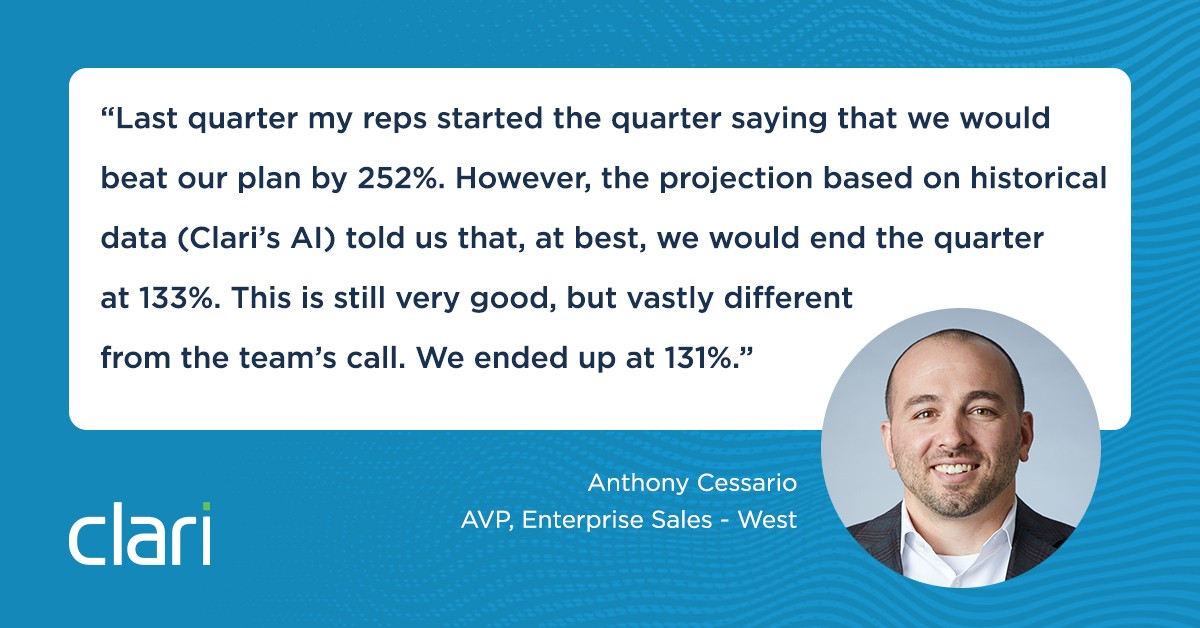For most sales leaders, the week 1 forecast is often closer to a New Year’s resolution than it is an accurate projection of how much revenue your team is going to bring in for the quarter. In fact, most sales leaders’ “forecasts” don’t get within 10% accuracy until week 10 or week 11 of the quarter.
Now finishing my 2nd quarter at Clari (both of which we started the quarter with a revenue prediction that was within 2% of where we ended week 12,) I am a true believer in the full funnel accountability that AI & ML combined with clean data and the right process rigor can deliver.
And I’m here to share the 4 steps it takes to deliver this level of revenue predictability:
- Step 1: Triangulate a reality check
- Step 2: Inspect current and out-quarter pipeline
- Step 3: Conduct data-driven 1:1 coaching sessions
- Step 4: Bring your revenue teams together
But first, why is this so important?
The Mandate for Predictable Revenue
With almost every industry being disrupted by new service delivery models, and major liquidity/consolidation events showing no signs of decline in industries such as cybersecurity, SaaS and networking; boards and executive leadership teams are placing a hyper-focus on delivering much more predictable revenue to shareholders and the street.
To do that, they are looking to AI & machine learning for help.

As the leader of Clari’s Enterprise Revenue team here in the West, I have the opportunity to sit down with CROs, CMOs, sales theatre leaders and RevOps leaders from some of the highest growth and most innovative companies in the world.
Here are a few observations:
- These companies have world-class talent in their sales, marketing, and operations groups.
- Many employ teams of data scientists.
- They have countless terabytes of data across the sales, marketing, finance and customer success functions for their data scientists to analyze.
- Even with all this investment, these revenue leaders still can’t accurately forecast revenue much better than the weather team forecasts the weather (things are pretty “foggy” more than 10 days or so out). Why is that?
In our experience, it’s typically due to a lack of visibility and accountability across the revenue funnel. To deliver an accurate forecast as early as week 1 in the quarter, many things need to align. You need (we’ll get into each of these a bit further down):
- Agreed upon definitions: Revenue teams must agree on pipeline definitions and targets going into the quarter
- Strategies for spotting risk: A data-driven way to identify risk in the pipeline with GTM sales motions to mitigate that risk
- Visibility into velocity: A strong grasp on pipeline velocity and how it differs from rep to rep
- Clear guidelines: A sales methodology that’s adopted and is easy to track against
- More coaching, less interrogation: Front line sales managers spending more time coaching reps on how to accelerate (the right) deals than they do asking reps to report the news on those deals
- Automatic sales activity tracking: Reps actually updating the important information on those deals regularly with intelligent automation tracking the things that reps aren’t updating (think activity data such as meetings, interactions, contacts they’re meeting with, etc).
And if you have all of the above aligned, you will then need relevant and actionable historical time series data for the revenue leaders to triangulate against.

At Clari we get to speak to hundreds of the fastest growing B2B tech companies in the world. Most revenue teams would rate themselves at best a “C” in any of these areas.
I was one of those “C” revenue leaders prior to joining Clari, who wanted to do better but didn't have the path or the tools to do so. Executing on anything I just shared would not only have been a New Year’s resolution for my team, but it would also have been a radical pipe dream.
Here is the 4 step process we go through here to consistently deliver quarterly revenue predictions with 98% accuracy as early as week 1 in the quarter.
Step 1: Triangulate a reality check (Video)
The first step is to triangulate between what history is telling you, what your team is telling you and what you’re being asked to deliver.
Typically these steps happen in reverse order: You look at what you’re being asked to deliver on as a team, then you look at what the sales reps are rolling up for their commit, upside and best case.
For a lot of leaders, it stops there. The only historical analysis being done at this point is happening in their own heads. This typically culminates with a feeling of excitement, panic and/or skepticism that ultimately influences the revenue prediction (“forecast”) you make for your business.
This step is where AI/ML is changing the game.

For Clari customers, Clari’s Time Series Data Hub is historically tracking and time-stamping every single field in the CRM every 15 minutes. It then analyzes those millions of data points all the way down to the sales rep level, looking back at 2 years of data and predicting not only the likelihood of each deal coming in that quarter, but also how much pipeline will likely be needed to deliver on the number you’re being asked to hit based on historical conversion rates.
Our data science is taking into consideration each individual rep’s unique behavior (sandbaggers, happy ears and everything in between) and using that to drive our predictive models.
In my business, once I have a sense of what I need to deliver on, what my team is saying we can deliver on, and what the historical data is telling me we have the ability to deliver on, I look for discrepancies.
Last quarter my reps started the quarter saying that we would beat our plan by 252%.
However, the projection based on historical data (Clari’s AI) told us that, at best, we would end the quarter at 133%. This is still very good, but vastly different from the team’s call.
We ended up at 131%.
Clari clearly saw risk in our pipeline that our reps were not seeing. I trusted Clari’s data science and called the 133% number, then began inspecting the pipeline to see what Clari’s AI was seeing that we weren’t.
Here's what it looks like in real-time:
Stay tuned for steps 2-4 and subscribe to the blog to get alerts when they're live.
- Step 1: Triangulate a reality check.
- Step 2: Inspect current and out-quarter pipeline. With insights from the previous step in hand, I'll share how to look for risk in the current quarter and opportunities to accelerate deals that are slated for end of quarter or for out quarter.
- Step 3: Conduct data-driven 1:1 coaching sessions. Armed with data around deals at risk, I'll explain how to head into your 1:1s with a data-driven POV so you can coach instead of interrogate.
- Step 4: Bring your revenue teams together. One of the benefits of pressure testing out-quarter deals and forecasting out-quarter pipeline is that this forward-looking visibility gives the entire revenue team much more confidence in the pipeline going into the quarter. I'll walk through what this looks like.
Interested in hearing more? I’m happy to share my learnings. Email me at a ac@clari.com or request a demo from one of our Clari experts.



